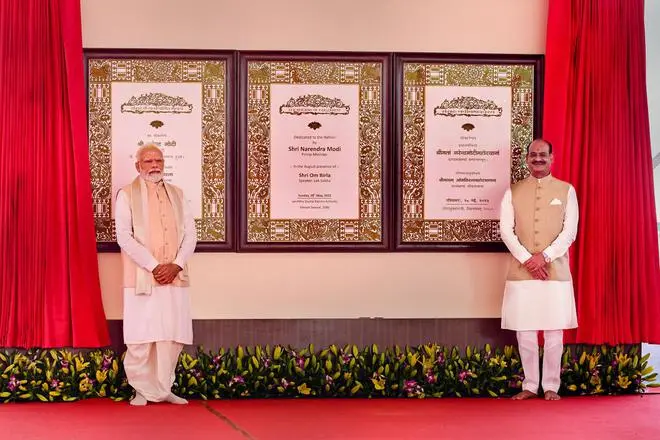India’s corridors of power are getting a makeover — part of Prime Minister Narendra Modi’s efforts to cement his legacy as he looks to a third term in office in national elections next year.
Modi, who is spearheading a sweeping revamp of the colonial-era center of the Indian capital, inaugurated a new parliament house Sunday — a four-story modern structure built at a cost of 9.7 billion rupees ($117 million). The new building is expected to replace the century-old one where independent India’s constitution was adopted.
It’s part of the Central Vista project — a redesign of a historic stretch of monuments and government buildings between New Delhi’s famous India Gate and the sprawling red sandstone presidential palace — designed by British architects Edwin Lutyens and Herbert Baker in the early 20th century.
The project kicked off soon after Modi returned to power with an even bigger mandate in 2019 and is set to cost 200 billion rupees.
Ahead of the unveiling, Modi urged Indians to share a video he posted on Twitter of the new parliament.
The redevelopment has become one of the most controversial urban architectural projects since independence. There’s criticism it erases a part of New Delhi’s heritage that has spanned more than a century, and Modi is accused of using it to promote his ruling Bharatiya Janata Party’s Hindu nationalist ideology.

Prime Minister Narendra Modi with Lok Sabha Speaker Om Birla during the inauguration of the new Parliament building, in New Delhi, Sunday, May 28, 2023. (PTI Photo)
Sunday’s ceremony was held on the 140th birth anniversary of Hindutva ideologue Vinayak Damodar Savarkar, popularly known as Veer Savarkar. Modi had marked the start of the construction of the new building with a Hindu prayer ceremony in December 2020. On Sunday, Modi inaugurated the new building in the presence of Hindu priests chanting ancient Vedic scripts.
“The inauguration of the new parliament building by Prime Minister Modi marks a key moment in his efforts to establish himself as the head of a new Hindu nationalistic India,” said Nilanjan Mukhopadhyay, a New Delhi-based political analyst and a Modi biographer. “The inauguration is part of the symbolism underway to rid India of its inclusive heritage and adoption of a unitary, or Hindu, legacy as India’s only past.”
Modi’s administration said the project will help meet the need for more office space and create modern residences for the prime minister and vice president. The redevelopment is a testament to Modi’s “vision of creating a new India, which combines modernity with our heritage and traditions,” Home Minister Amit Shah said in a recent presentation.
Last year, Modi inaugurated a redeveloped boulevard that was once named in honor of British monarch George V, who was the Emperor of India at the time the avenue was built. It was called Kingsway after a similar arterial path in London and later renamed Rajpath following India’s independence in 1947, a loose translation into Hindi.
The boulevard is now known as Kartavyapath — or the Path of Duty — and Modi said the decision to rename it erases another symbol of colonialism in India.
“Rajpath, the symbol of slavery, has become a matter of history from today and has been erased forever,” he said at the time.
(PTI)
Criticisms linger that the new parliament is a vanity project to help boost Modi’s image ahead of the 2024 national vote.
About one third of the country’s federal lawmakers — including those from the main opposition Congress party — boycotted Sunday’s ceremony. They said India’s president, who is the head of state, should open the parliament building instead of Modi.
“The parliament is a hallowed institution,” Modi’s governing coalition said in a statement. “Such flagrant disrespect towards this institution betrays not only intellectual bankruptcy but a disturbing contempt for the very essence of democracy.”
- Also read: A look at the carpets for the new Parliament




Comments
Comments have to be in English, and in full sentences. They cannot be abusive or personal. Please abide by our community guidelines for posting your comments.
We have migrated to a new commenting platform. If you are already a registered user of TheHindu Businessline and logged in, you may continue to engage with our articles. If you do not have an account please register and login to post comments. Users can access their older comments by logging into their accounts on Vuukle.